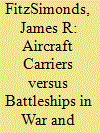|
|
|
Sort Order |
|
|
|
Items / Page
|
|
|
|
|
|
|
| Srl | Item |
| 1 |
ID:
175181


|
|
|
|
|
| Summary/Abstract |
Since the end of World War II, the aircraft carrier has been commonly portrayed as the ultimate element of sea power. This notion of carrier supremacy is based largely on the prevalent belief that carrier-based aircraft were so lethal during the Second World War that they rendered surface combatants, most notably battleships, powerless against air strikes. Yet a close reading of the history of combat at sea during World War II fails to support this contention. The battleship proved the most resilient surface ship and remained the ultimate determinant of sea control. The idea that the aircraft carrier supplanted the battleship as the dominant naval platform is a myth.
|
|
|
|
|
|
|
|
|
|
|
|
|
|
|
|
| 2 |
ID:
175174


|
|
|
| 3 |
ID:
175178


|
|
|
|
|
| Summary/Abstract |
This article examines the socio-cultural dynamics that characterized the interaction between American troops and the representatives of the YMCA in France during the First World War. Soldiers and Marines critiqued the YMCA’s shortcomings as the self-proclaimed guardian of American troops’ material comfort and moral welfare. A closer examination reveals their critique transcended petty complaints about the YMCA’s policies and conduct. Soldiers linked their dissatisfaction with the Association’s misdeeds to what they perceived as disturbing phenomena unfolding on the home front: intrusive and arbitrary forms of social control, profiteering, draft evasion, and a skewed conscription system. This demonstrates the central role perceptions of the home front played in shaping soldiers’ ideas about the value of their sacrifices.
|
|
|
|
|
|
|
|
|
|
|
|
|
|
|
|
| 4 |
ID:
175180


|
|
|
|
|
| Summary/Abstract |
To date evaluations of tactical air supremacy during the Normandy campaign of 1944 have tended to analyse the erosion of German fighting ability due to the destruction to the transportation system, especially bridges and railways, by Allied air and the Resistance. Attacks on depots have been considered but not in the context of assessing the effectiveness of Allied intelligence gathering on depots. This study presents that analysis. Using archival sources in combination with geoarchaeological records, we hypothesise how a crisis in German logistics could have produced an earlier collapse of German capability, had Allied intelligence been more accurate in reporting German supply activities.
|
|
|
|
|
|
|
|
|
|
|
|
|
|
|
|
| 5 |
ID:
175182


|
|
|
| 6 |
ID:
175175


|
|
|
|
|
| Summary/Abstract |
The military revolution thesis posited by Michael Roberts and expanded on by Geoffrey Parker places the trace italienne style of fortification of the early modern period as a novel creation, born out of the minds of Renaissance geniuses. Research shows, however, that the trace italienne’s key component, the angled bastion, has its roots in Greek and Roman writings, and in extant constructions by Roman and Byzantine engineers. The angled bastion of the trace italienne was yet another aspect of the resurgent Greek and Roman culture characteristic of the Renaissance. The writings of the ancients were bolstered by physical examples located in important trading and pilgrimage routes.
|
|
|
|
|
|
|
|
|
|
|
|
|
|
|
|
| 7 |
ID:
175176


|
|
|
|
|
| Summary/Abstract |
The Union war effort west of the Appalachians during the American Civil War depended on the ability to supply and defend the massive Union depot in Nashville, Tennessee. Detailed analysis of the logistical problems in supplying Nashville Depot from late February 1862 through April 1865—via the Louisville and Nashville Railroad and the Cumberland River—reveals how the depot was able to support the thousands of Federal troops occupying the city, and also feed, clothe, and arm nearly 150,000 troops during periods of significant guerrilla insurgency. Logistical necessity required control of the Cumberland River from its mouth on the Ohio River to Nashville, and the U.S. Navy was essential to this strategic imperative.
|
|
|
|
|
|
|
|
|
|
|
|
|
|
|
|
| 8 |
ID:
175179


|
|
|
|
|
| Summary/Abstract |
The article analyzes the causes of the Italian Navy’s delay in developing new technologies during the interwar years. The wider institutional panorama of Fascist Italy, characterized by the polycratic chaos typical of totalitarian regimes and interservice rivalry, combined with naval cultural opposition to technological change, rooted in part in the Italian naval officers corps. Employing new archival sources, the essay explains how the institutional-cultural background hampered scientific cooperation between the Navy, other armed forces, and national scientific institutions. The slowdown in Italian naval technological development and its subsequent failure to develop new technologies such as radar and sonar were a central cause of the Italian fleet’s poor performance in the Second World War.
|
|
|
|
|
|
|
|
|
|
|
|
|
|
|
|
| 9 |
ID:
175177


|
|
|
|
|
| Summary/Abstract |
This article examines the British Expeditionary Force’s (BEF’s) use of field fortifications at the Battle of the Aisne in September and October 1914. It concludes that the BEF implemented a tactically robust and effective field works system that it quickly adapted to suit the unprecedented conditions of the battle. Thus, the army was more prepared for the combat realities of 1914 than much of the scholarship since the 1970s has implied. The BEF, however, struggled to apply the lessons of the Aisne in Flanders in late October 1914, portending the learning curve that characterized tactical development in 1915–18.
|
|
|
|
|
|
|
|
|
|
|
|
|
|
|
|
|
|
|
|
|